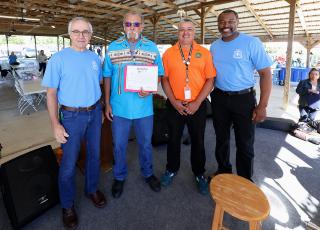Tribal, bi-regional partnership builds future workforce with Indian Youth Service Corps

OKLAHOMA — An agreement between the United Keetoowah Band of Cherokee Indians in Oklahoma and the USDA Forest Service is advancing the agency’s commitment to partner with Tribal Nations and helping to develop the next generation of natural resource managers.
Through the bi-regional Indian Youth Service Corps program, young people from the UKB will have the opportunity for hands-on training on national forests in the Eastern and Southern regions with an emphasis on projects on Forest Service-managed ancestral lands and culturally significant sites. In early October, Forest Service leadership and staff were invited to the UKB’s annual tribal celebration in Tahlequah, Oklahoma, to sign a proclamation recognizing the significance of this new agreement.
In this first-of-its-kind bi-regional program, the Eastern and Southern regions were able to secure funding for four years under a streamlined, simplified national agreement. With stable funding, primarily from Washington Office Reforestation Trust funds, the program can help meet workforce development goals in both regions.

“We are very excited to have a multi-year fully funded agreement in place that will provide the certainty of continuing this relationship between the UKB and the USDA Forest Service,” said Jim Copeland, deputy regional forester for the Eastern Region. “This agreement is an unprecedented opportunity to partner on priorities across regions, co-manage risks, share resources, learn from each other and build capacity to improve forest conditions.”
During each year of the agreement, an eight-person Indian Youth Service Corps crew receives stipends for their work during a four-week session on the Cherokee National Forest in eastern Tennessee and a four-week session on the Shawnee National Forest in southern Illinois. Before the agreement was signed, the Cherokee and the Shawnee had separately hosted youth and young adult conservation programs with the UKB for three years of summer sessions since 2019. But these separate agreements faced challenges with unreliable funding and position vacancies.
Now, with the bi-regional agreement, the Indian Youth Service Corps provides even greater benefits to everyone involved, including tribes, the public and the program participants. Indian Youth Service Corps projects support cultural resource preservation, tourism, outdoor recreation and natural resource protection and conservation. The hands-on training bolsters skills needed in the future workforce for land management agencies while giving young people broad exposure to possible career paths in cultural and natural resource management.

“This is a fantastic program that offers a venue for young adults to learn about conservation and prepares them for future job opportunities,” said Ken Arney, regional forester for the Southern Region. “Closely partnering with tribal nations in the management of Forest Service lands is one example of our commitment to co-stewardship and a core value of interdependence.”
The experience opens doors for participants as they consider future career options. Working on an Indian Youth Service Corps crew counts as hours toward the Public Land Corps Noncompetitive Hiring Authority. With 640 hours, participants earn noncompetitive status for up to two years, which enhances access to federal job opportunities by streamlining the process to be hired for permanent positions at the Forest Service and other public land management agencies. Participants also learn about applying for federal jobs as well as careers within the Tribal governments and nonprofit partners.
Summer 2023 marked the first year of the four-year agreement for the bi-regional Indian Youth Service Corps program. During the sessions on the Cherokee and Shawnee national forests, participants engaged in silviculture, reforestation, cultural survey, timber stand improvement, botanical survey, wildlife monitoring and archaeological excavations; learned about stream ecology, fisheries and basic forestry concepts and practices; and took part in several conservation education opportunities and heritage site visits that connected them with their ancestral homelands.
